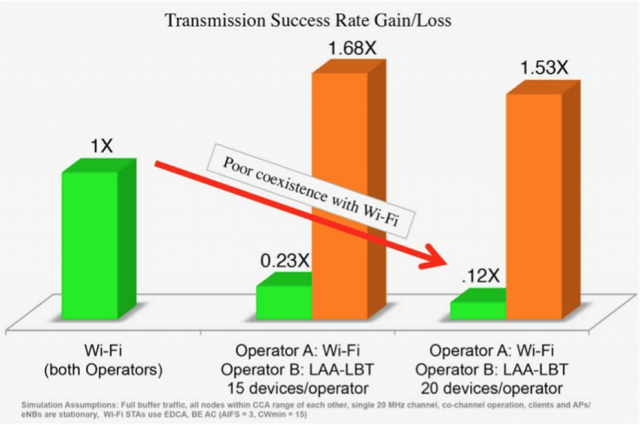
Critics question the wireless industry’s claim LTE-U and Wi-Fi can co-exist peacefully. (Image: EVOLVE)
Consumer groups and cable operators are warning the Federal Communications Commission a plan by the nation’s largest wireless carriers to introduce premium Wi-Fi services for their mobile customers may create serious interference problems for existing Wi-Fi users.
AT&T, Verizon, and T-Mobile are all members of EVOLVE, a group advocating for LTE-U and LAA, technologies that will depend largely on the unlicensed Wi-Fi bands to deliver wireless data to their mobile customers.
Cable operators fear the proposal will give mobile providers an unfair advantage, introducing more traffic into the already crowded Wi-Fi bands while mobile operators reserve the right to use a licensed control channel to shift their customers’ traffic back and forth between unlicensed and licensed spectrum at will. Cable industry critics of the plan claim allowing mobile operators to dump customer traffic into the Wi-Fi bands is likely to worsen interference, harming the cable operators’ investment in a growing network of Wi-Fi hotspots and in-home Wi-Fi.
Consumer groups agree with the cable industry.
The Open Technology Institute at New America, Public Knowledge, Free Press, and Common Cause have filed a joint statement with the FCC warning the agency “mobile carriers will have both the ability and strong incentives to use LTE-U and LAA to engage in anti-competitive behavior harmful to consumers,” all while making a tidy profit charging customers for the use of a service comparable to Wi-Fi, now a free alternative to the carriers’ 3G and 4G data networks.
The groups argue Wi-Fi standards were developed with unlicensed users in mind, able to co-exist peacefully with other similar Wi-Fi signals. The proposed LTE-U technology from wireless carriers is far less sensitive to neighboring signals.
“LTE-U/LAA is designed to be centrally controlled by a network anchored in a separate, exclusively licensed frequency band,” the consumer groups wrote. “3GPP, the mobile industry standards body, may ultimately design LAA in a manner that shares fairly with Wi-Fi and other unlicensed technologies; yet several studies filed by commenters demonstrate that the version of LTE-U that U.S. carriers plan to deploy by next year coexists poorly with Wi-Fi, degrading both throughput and latency (delay).”
 Critics contend the wireless industry’s proposed service is not as likely to use “Listen Before Talk” effectively, a standard that checks for existing traffic before powering up on an unlicensed frequency. Consumer groups fear mobile carriers will have both the ability and a strong incentive to use LTE-U and LAA to charge consumers for the use of unlicensed spectrum and give themselves an unfair advantage by escaping the interference its own technology can cause other users.
Critics contend the wireless industry’s proposed service is not as likely to use “Listen Before Talk” effectively, a standard that checks for existing traffic before powering up on an unlicensed frequency. Consumer groups fear mobile carriers will have both the ability and a strong incentive to use LTE-U and LAA to charge consumers for the use of unlicensed spectrum and give themselves an unfair advantage by escaping the interference its own technology can cause other users.
“Carriers also have powerful incentives to use LTE-U to deter mobile market entry by ‘Wi-Fi First’ providers, such as wireline ISPs,” argue the consumer groups, also referring to independent providers like Republic Wireless that depend primarily on Wi-Fi for smartphone connectivity. “Carriers deploying LTE-U will have the apparent option to adjust their access points to introduce just enough latency to frustrate consumer use of real-time applications, such as video calling.”
Another incentive is money. For several years, wireless carriers have encouraged customers to offload their mobile data traffic to Wi-Fi. But since Wi-Fi traffic does not count against the customer’s usage allowance, it also reduces revenue opportunities. LTE-U is a variant of LTE, and carriers traditionally do count that traffic against a customer’s usage allowance. For the first time, mobile customers will accrue usage charges based on their use of unlicensed frequencies. For some, they may have no other choice.
Ellen Satterwhite, a spokesperson for WifiForward, a coalition of companies advocating for more unlicensed spectrum for Wi-Fi, said LTE signals never play well with traditional Wi-Fi.
“When LTE and Wi-Fi signals collide, LTE wins,” Satterwhite said.
“The wireless carriers have completely changed their tune about Wi-Fi—because they have to,” said David Callisch, vice president of corporate marketing for Ruckus Wireless, a Sunnyvale, Calif.-based maker of Wi-Fi hardware, whose customers include Verizon and AT&T. “Wi-Fi for them is like a train going down the track,” Callisch told Bloomberg BNA in an interview. “You could get hit by it or you could jump on the train. They’re jumping on the train.”
“Carriers have historically hated Wi-Fi, because they can’t control it,” Callisch added. “They’ve always liked the licensed band, because they can buy it and they can control it and they can deliver a quality of service to customers over it. With Wi-Fi, you can’t do that.”
But with LTE-U they have the control they crave, able to use network management technology that prioritizes their customers over other conventional Wi-Fi users. Even better, they can charge customers for using it.
Both cable operators and consumer groups want engineers, not business executives, to carefully develop standards and rules that guarantee Wi-Fi users can co-exist with other users of unlicensed frequencies before the technology is switched on.


 Subscribe
Subscribe